One of the defining images of World War II continues to be trailed by controversy.
-
September 2023
Volume68Issue6
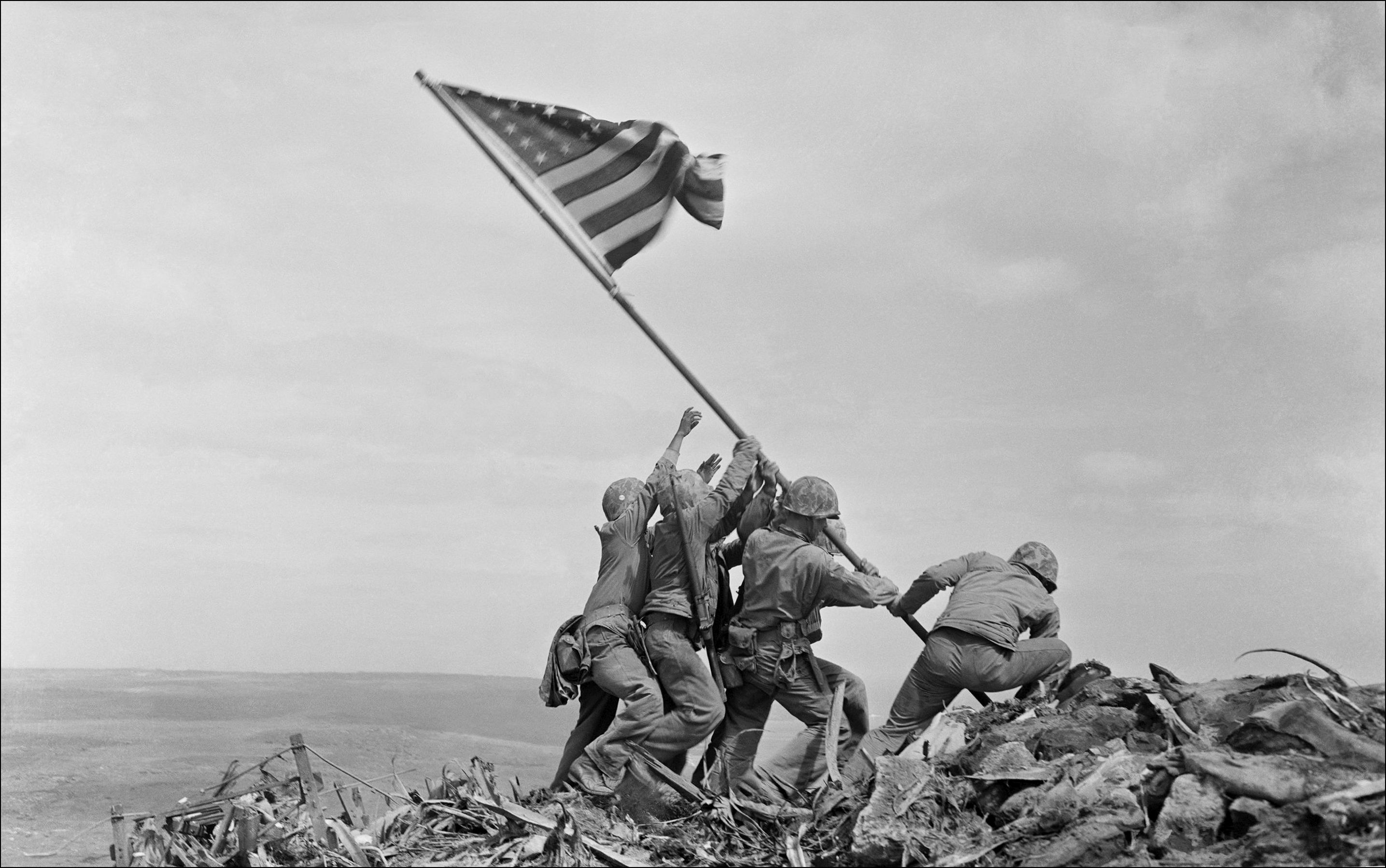
The photograph of Marines planting the American flag on Iwo Jima continues to be one of the most inspiring images of World War II. But many people, including visitors at the Newseum in Washington, D.C. when I volunteered there as a tour guide, routinely claimed that the photo was posed. So, I decided to look into the evidence.
Joe Rosenthal had been disappointed that he couldn’t follow his two brothers into the Army. It was ironic that he was rejected for poor eyesight, as he had worked as a photographer in the San Francisco bureau of the Associated Press.
He was determined to contribute to the war effort one way or another, so he settled for a photography assignment with the U.S. Maritime Service.
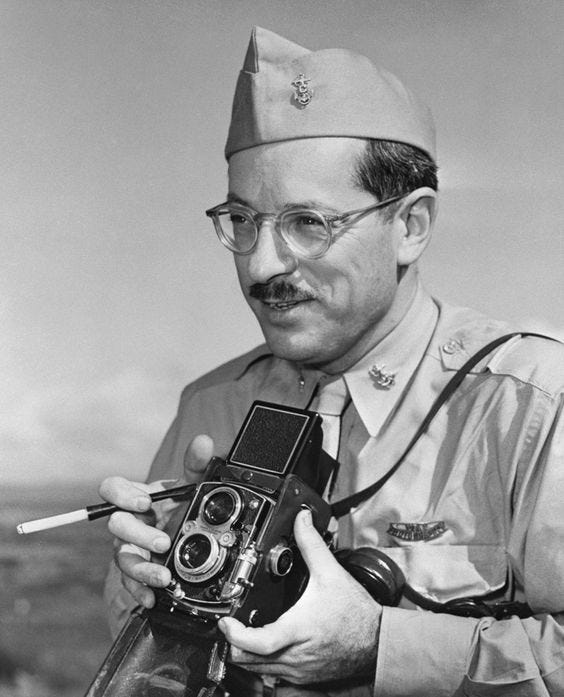
“They wouldn’t let me carry a gun,” he said, “but I could pack my camera right with the boys in the front lines and show them fighting.”
He saw duty in the Mediterranean and England. But he was never in the midst of the action. So, he rejoined the AP in 1944 and secured an assignment as a war correspondent, shipping out to the Pacific that spring. He followed the action from island to island, and on February 19, 1945, went ashore on the first day of fighting on Iwo Jima.
Thanks to vastly improved communications by that point in the war, his photographs from the first few days of the invasion appeared in newspapers everywhere within a day or two. But that was nothing, compared to what was to come on the Marines’ fifth day ashore on Iwo, February 23.
The casualties already had been horrific. By the time the American flag was raised over Mt. Suribachi on February 23, more than 6,000 Marines and 700 sailors had been killed, and 19,000 Americans wounded.
Iwo Jima was “the most costly fight in which the Marines have ever been engaged,” AP correspondent Elmont Waite wrote in a story filed that day. He was writing from Guam, headquarters of Admiral Chester Nimitz’s Pacific fleet, but his second paragraph mentioned what would be the enduring image of the day: “The Stars and Stripes were raised over the volcanic Suribachi fortress 97 hours after the costly invasion began.”
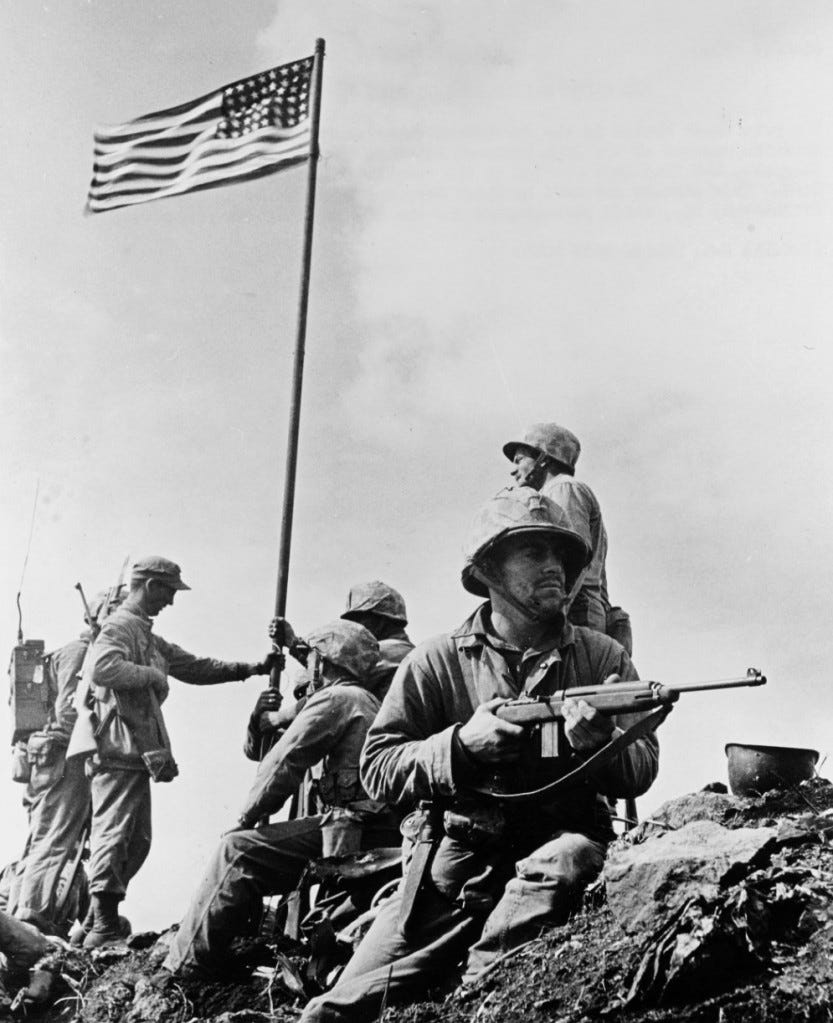
Lt. Harold G. Schrier of E Company, 28th Marines, had begun that day with a specific assignment: take a 40-man patrol to the top of Mount Suribachi and plant a U.S. flag at the summit. By about 10:30 a.m., he and his men had done exactly that in the face of unexpectedly light Japanese resistance.
The men tied a small flag that Schrier carried up the mountain to a length of pipe they had found among the debris at the summit, and raised it as ordered, drawing cheers from every U.S. serviceman who could see it. The moment was captured for posterity by a Marine Corps photographer, Staff Sgt. Louis R. Lowery.
There was just one problem: the flag wasn’t very imposing as it fluttered atop the 550-foot volcano, so a larger flag was sent up to replace it.
Joe Rosenthal was making his way up the mountain at this point, accompanied by Marine Corps photographers Sgt. Bill Genaust and Pvt. Bob Campbell. They ran into Lowery on the way, and he told them he’d already made photos of the flag, but there was a great view from the top. They decided to keep going.
Arriving at the summit, Rosenthal learned of the plan to swap out the flags. He considered trying for an angle that would allow him to get both the smaller flag being lowered and the larger flag being raised in the same frame, but thought there was too great a risk of missing the shot.
“I might not catch the two together, and even if I did, it would be divided actions in the photo,” he told the San Francisco Examiner in 1995. “A news photo has got to have a central punch to it. But what mattered was that our flag was up there and I wanted to get a picture of it.”
Rosenthal stood only 5-foot-4, so he perched on a makeshift pile of sandbags and rocks to get a better angle. Just as he felt that he was set, he saw movement in his peripheral vision — the replacement flag was being raised by five Marines and a Navy corpsman.
Rosenthal turned his Speed Graphic camera toward the action and pressed the shutter, creating one of the most recognizable images in the history of photography.
Rosenthal didn’t even know if he had made a usable picture. “One never does on any news photo that you ever shoot,” he said later about the era before digital cameras. “You hope it’s good. I was looking through the viewfinder as I shot it. I shot it where I thought it should be a good picture, and that’s about as far as you can go.
“I had no idea that it was a matter of being historic or that it would last for some time as a photo. Rather, I saw it as representing a turning point in the battle. The seizure of Suribachi meant that troops dedicated to the southern part of the island could be released to augment the march up to the widening part of the island.”
Because he was a wire-service photojournalist, that was the most someone like Rosenthal could hope to achieve on any given day: create a picture that helps tell the story of the moment. But this frame would far outstrip that modest goal.
Following the same procedures he had used throughout his Iwo Jima coverage, Rosenthal sent his film back to Guam via plane for processing. From there, the flag-raising photo and other selections were transmitted to the AP bureau in San Francisco over U.S. Navy radio circuits, then on to New York for worldwide distribution.
Photo editors knew a classic when they saw one, and there was no denying the brilliance of the scene Rosenthal had captured. They rushed it onto the AP’s Wirephoto service in time to make the all-important Sunday editions on February 25. The photo dominated the front page of that day’s New York Times, running under type that read “Old Glory Goes Up Over Iwo,” and it received similar play from coast to coast — an instant classic.
Rosenthal had no idea. Though he had started to hear some buzz that one of his photos was making waves back home, he thought it might be another he had made after the flag was up, a posed shot of more than a dozen men that he dubbed the “gung-ho” photo.
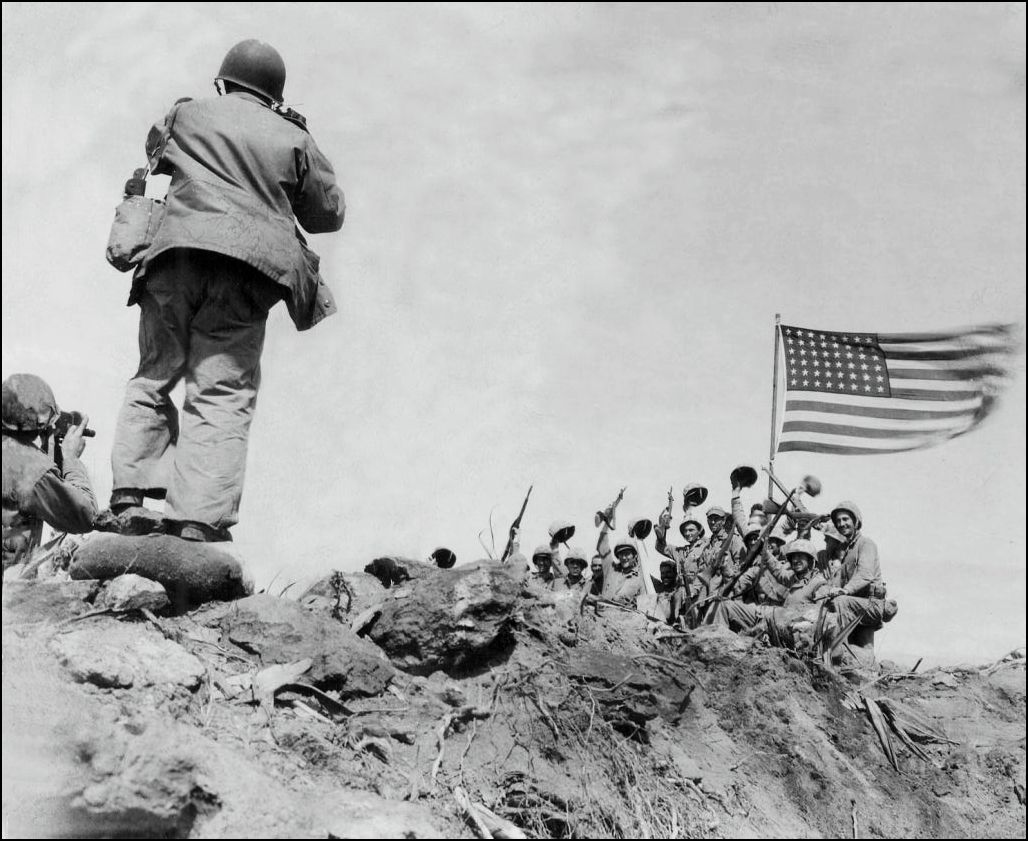
This uncertainty was at the root of a controversy that would dog him for decades. Rosenthal caught a flight back to Guam a few days after the flag-raising photo had been published, and someone there asked him whether his picture had been posed. Assuming that the questioner meant the gung-ho photo, he said “Sure.”
Time and Life correspondent Robert Sherrod, one of the most influential journalists in the Pacific, thanks to his legendary coverage of the fighting at Tarawa, heard a version of that anecdote and sent a cable to his editors in New York saying that the flag-raising photo had been staged by Joe Rosenthal.
Time leveled that accusation on its radio show days later, but retracted it almost immediately and apologized to Rosenthal. That wasn’t enough; many people believe to this day that the flag-raising shot was staged.
Regardless of the accusations that would follow and endure, the photo struck an immediate chord with the public, even inviting comparisons to famous works of art.
It ran across the entire front page of the February 25 New York Daily News, and the caption beneath it alluded to The Spirit of ‘76, Archibald Willard’s famous depiction of the American Revolution. Other outlets drew the same parallel.
The February 27 editions of the Oregon Statesman featured a column by Charles A. Sprague that waxed poetic on the emotions it evoked. It concluded with this:
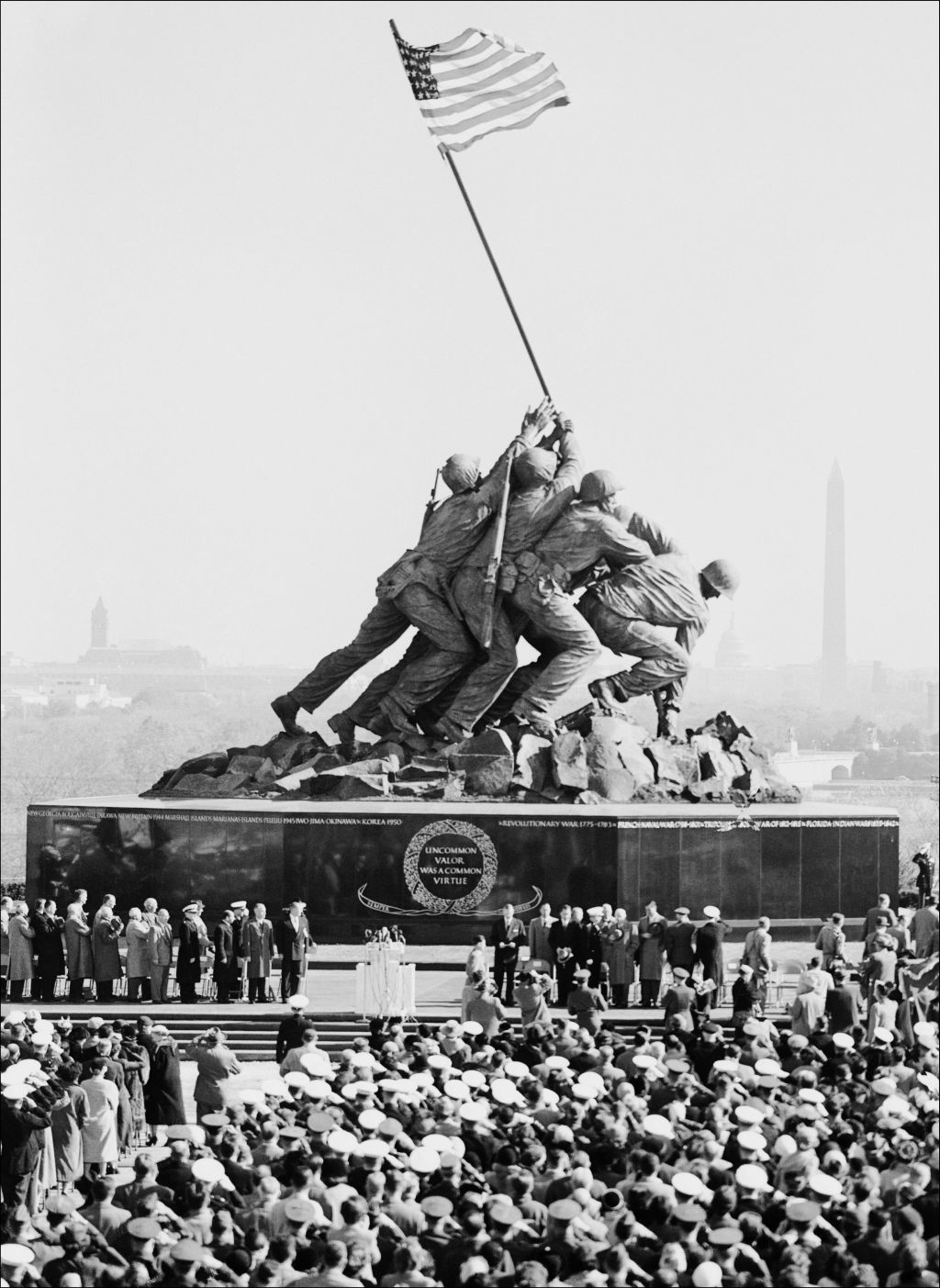
Sprague certainly was prescient in that assessment. Less than three months after publication, various artists’ interpretations of the photo were featured in millions of posters for the 7th War-Loan fundraising drive, and by July of 1945, yet another version of it appeared on a 3-cent postage stamp. Rosenthal won the Pulitzer Prize that spring after the committee made an exception to its usual rule that only entries created in the previous calendar year would be considered.
Before 1945 was out, Congress commissioned the sculptor Felix de Weldon to use this photo as the basis for the Marine Corps War Memorial, which was completed in 1954 and dedicated on November 10 of that year — the 179th anniversary of the founding of the Marine Corps. Rosenthal attended that ceremony, along with President Dwight D. Eisenhower and Vice President Richard M. Nixon.
After the war, Rosenthal worked for more than 30 years as a photographer at the San Francisco Chronicle. He would spend the rest of his life talking about that day on Iwo Jima, and he always attempted to steer the conversation toward the men who did the fighting.
“I’m not a heroic guy,” he told the Examiner in 1995. “I hate to veer into anything that makes it sound heroic. If there’s any heroism connected with it, it’s putting up with the things that come along with being known as The Photographer of this particular picture. The photo has a good purpose in the attention it brings to what these men accomplished. Also, it helps recruiting, and it helps the spirit of the young Marines. I don’t know how many thousands of them I’ve had come up to me to talk about it. I’m aware that it means something to them, and I’m glad of it.”
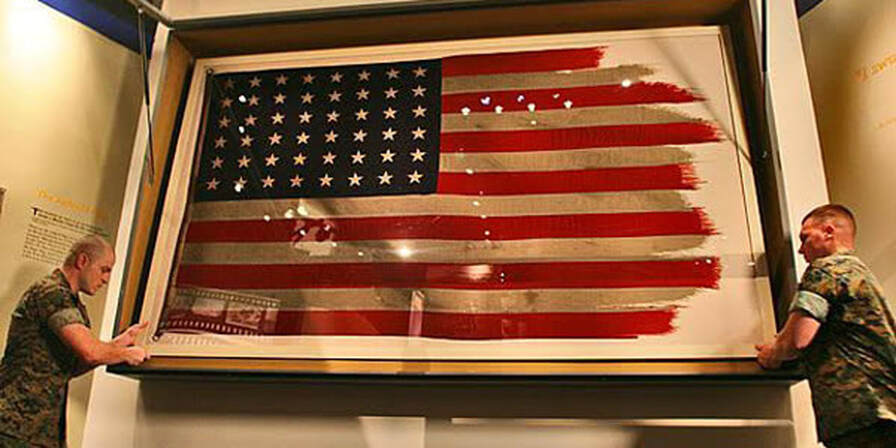
“I was a very fortunate guy. I also have a lot of insight on a lot of people who were there. I have great respect for the people who were there. I don’t know, had I been accepted into the service myself, whether I could have measured up. I sure as hell would have tried.”
Both flags that were raised over Mount Suribachi that day in February 1945 are on display at the National Museum of the Marine Corps in Triangle, Virginia.

